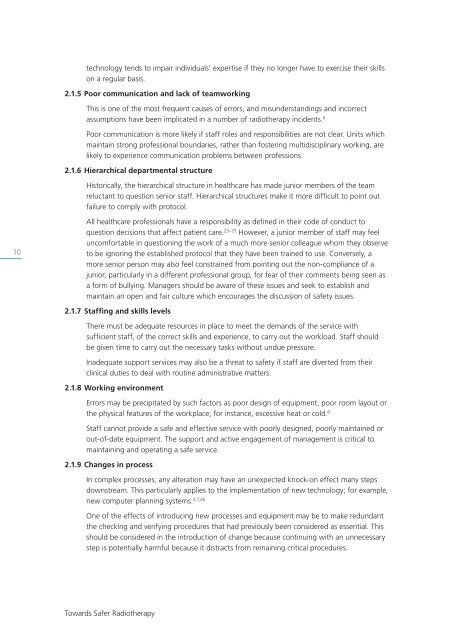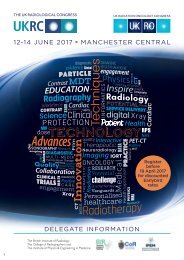Towards Safer Radiotherapy
Towards Safer Radiotherapy
Towards Safer Radiotherapy
Create successful ePaper yourself
Turn your PDF publications into a flip-book with our unique Google optimized e-Paper software.
technology tends to impair individuals’ expertise if they no longer have to exercise their skills<br />
on a regular basis.<br />
2.1.5 Poor communication and lack of teamworking<br />
This is one of the most frequent causes of errors, and misunderstandings and incorrect<br />
assumptions have been implicated in a number of radiotherapy incidents. 6<br />
Poor communication is more likely if staff roles and responsibilities are not clear. Units which<br />
maintain strong professional boundaries, rather than fostering multidisciplinary working, are<br />
likely to experience communication problems between professions.<br />
2.1.6 Hierarchical departmental structure<br />
Historically, the hierarchical structure in healthcare has made junior members of the team<br />
reluctant to question senior staff. Hierarchical structures make it more difficult to point out<br />
failure to comply with protocol.<br />
10<br />
All healthcare professionals have a responsibility as defined in their code of conduct to<br />
question decisions that affect patient care. 23–25 However, a junior member of staff may feel<br />
uncomfortable in questioning the work of a much more senior colleague whom they observe<br />
to be ignoring the established protocol that they have been trained to use. Conversely, a<br />
more senior person may also feel constrained from pointing out the non-compliance of a<br />
junior, particularly in a different professional group, for fear of their comments being seen as<br />
a form of bullying. Managers should be aware of these issues and seek to establish and<br />
maintain an open and fair culture which encourages the discussion of safety issues.<br />
2.1.7 Staffing and skills levels<br />
There must be adequate resources in place to meet the demands of the service with<br />
sufficient staff, of the correct skills and experience, to carry out the workload. Staff should<br />
be given time to carry out the necessary tasks without undue pressure.<br />
Inadequate support services may also be a threat to safety if staff are diverted from their<br />
clinical duties to deal with routine administrative matters.<br />
2.1.8 Working environment<br />
Errors may be precipitated by such factors as poor design of equipment, poor room layout or<br />
the physical features of the workplace; for instance, excessive heat or cold. 6<br />
Staff cannot provide a safe and effective service with poorly designed, poorly maintained or<br />
out-of-date equipment. The support and active engagement of management is critical to<br />
maintaining and operating a safe service.<br />
2.1.9 Changes in process<br />
In complex processes, any alteration may have an unexpected knock-on effect many steps<br />
downstream. This particularly applies to the implementation of new technology; for example,<br />
new computer planning systems. 5,7,26<br />
One of the effects of introducing new processes and equipment may be to make redundant<br />
the checking and verifying procedures that had previously been considered as essential. This<br />
should be considered in the introduction of change because continuing with an unnecessary<br />
step is potentially harmful because it distracts from remaining critical procedures.<br />
<strong>Towards</strong> <strong>Safer</strong> <strong>Radiotherapy</strong>



